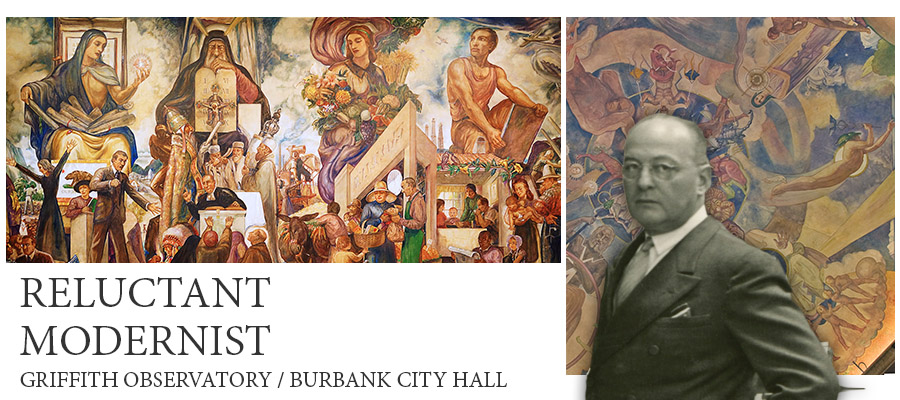Central Rotunda Ceiling
- John Mosley's Caption
- Allegory and History
- Source/Citations
From his pamphlet, ""The Hugo Ballin Murals at the Griffith Observatory" (Los Angeles: Published by the Griffith Observatory, Department of Parks and Recreation, City of Los Angeles, 1998):
“Our tour [of the ceiling] begins with the large figure opposite the main entrance, Atlas, who straddles the Big Dipper. He holds on his shoulders the twelve astrological signs of the zodiac, and they surround the opening to the Foucault pendulum. The small east and west winds float in front of him.
Moving counter-clockwise (to the right) we see six of his winged daughters, the Pleiades, who are fleeing the blind giants, Orion, below them. Orion’s guide Kedalion sits on his shoulders.
Continuing to the right, we see Jupiter holding thunderbolts and sitting behind the planet named after him. According to the artist, the large circle symbolizes perpetual motion.
The four falling children represent spring, summer, autumn, and winter. Below them is beautiful Venus, who was born out of the foam of the sea.
Continuing to the right takes us above the main entrance to Saturn, whose children, Ceres, Pluto, Juno, Vesta, and Neptune, are below. On learning that one of his children would dethrone him, Saturn swallowed them all whole. He is now about to drink the potion that will cause him to disgorge them. The ringed disk in front of him represents his planet.
To the right is Mercury, the messenger of the gods, who has wings on his hat and ankles.
The woman over the East Corridor holds the radiant Star of Bethlehem. Behind her, Aurora drives her steeds, which will sweep away the night. The seated man is an early observer of the heavens.
To her lower right is the moon, whose markings are Juno transformed into a cow. Below are the eyes of Argus, which today appear as the ornaments on a peacock’s tail. The many-legged figure falling in the flames towards the North Star is the artist’s conception of a comet.”
In his murals on the ceiling, Ballin abandoned the historical motifs of the murals on the rotunda walls and returned to the classical traditions of his early arts education. With brilliant colors, he depicted his interpretations of characters from ancient mythology associated with planets, stars and other astronomical phenomena. Ballin showed his reverence for transcendent stories like these myths throughout his career and here, he includes them alongside the "Advancement of Science" in the panels below. According to Mike Eberts' research on the observatory, that inclusion was in some cases a source of criticism, as some of the observatory's supporters worried that the murals in the ceiling would "cause people to confuse superstition for science." They likely believed that the point of the observatory was to replace fantastic visions of the heavens with the realities of space as seen through the Zeiss telescope. But, for Ballin, these myths had been just as important in advancing scientific understanding of the heavens as those telescopes and just as deserving of celebration and appreciation. In keeping with Griffith's belief that “awareness of the heavens was linked to self-development,” Ballin hoped to make the murals both educational and inspirational. He used "pure decorative beauty" to stimulate visitors and draw their eyes to the heavens above. That decorative beauty was intended to inspire awe and inspiration and encourage visitors to look to nature and find beauty in the world around them when they returned home after their visit to the Griffith Observatory.1
Caption excerpted from John Mosley's pamphlet, "The Hugo Ballin Murals at the Griffith Observatory" (Los Angeles: Published by the Griffith Observatory, Department of Parks and Recreation, City of Los Angeles, 1998)
1. Mike Eberts, Griffith Park: A Centennial History (Los Angeles: Historical Society of Southern California, 1996), pp. 185-186; 90.
Return to:

| Previous page on path | Griffith Observatory - Gallery, page 9 of 9 | Path end, return home |

Discussion of "Central Rotunda Ceiling"
Add your voice to this discussion.
Checking your signed in status ...